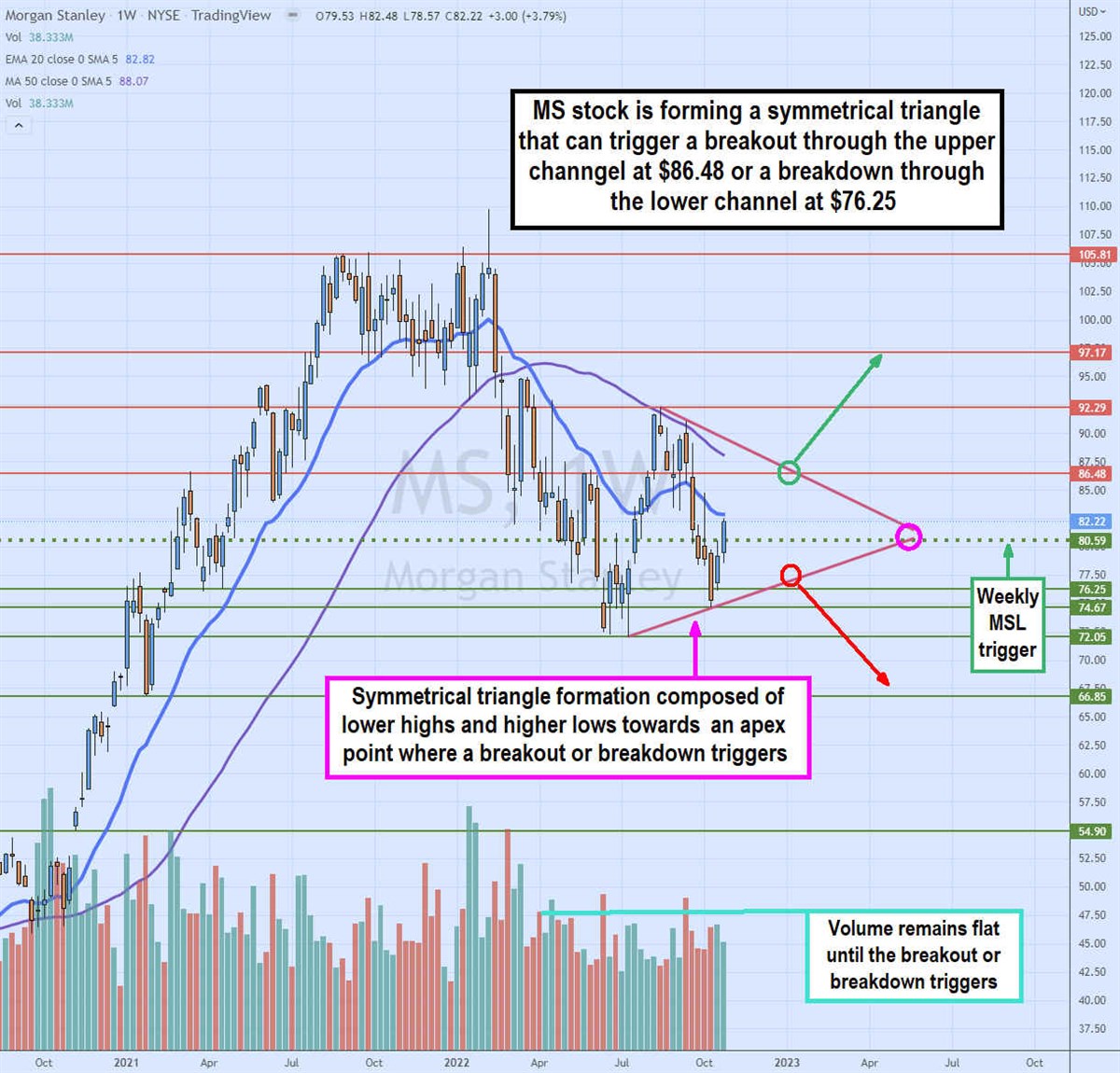
Investment banking and financial services company
Morgan Stanley NYSE: MS stock is trading down (-17%) compared to peers
Goldman Sachs NYSE: GS (-13%) and
Charles Schwab NYSE: SCHW down only (-6.5%). The blue shoe investment bank has implemented a strategy to diversify its services and clientele. It bolstered its
retail customer base with its $13 billion acquisition of E*TRADE in 2020. However, the advent of zero-commission trading from the likes of
Robin Hood NASDAQ: HOOD and Charles Schwab pressured Morgan Stanley to make a move. When it acquired E*TRADE, it also gained 5.2 million customer accounts with over $360 billion in assets to join its 3 million accounts and parlay its asset and wealth management services. The
uncertain macroeconomic headwinds have negatively impacted investment banking activity, but the Company was able to mitigate the weakness with a strong performance in
fixed income and equity. Rising
interest rates helped it achieve a 26.9% margin in its wealth management segment driven by higher net interest income.
Normalization overshot to the downside as the market climate completely reversed in 2022.
Key Points
- Morgan Stanley missed on both top and bottom line estimates in its Q3 2022 earnings report
- Last year SPAC business all but dried up causing normalization to overshoot to the downside with its investment banking business
- Asset and Wealth Management stepped up to the plate to offset some of the investment banking weakness
- 5 stocks we like better than Morgan Stanley

Weekly Symmetrical Triangle Forming on the Chart
The weekly candlestick chart for MS stock indicates the formation of a symmetrical triangle. This formation is composed of a declining upper channel as bounces make lower peaks and a rising lower channel as pullbacks fall to higher lows. Eventually, the upper and lower channel lines converge at the apex point. However, the breakout or breakdown tends to occur before the apex is reached as proverbial steam builds up for a break in either direction when the channel is broken. The upper channel breakout is around $86.48 and the lower channel breakout is near $76.25. The stock bounced through the weekly MSL trigger at $80.59 as it approaches the weekly 20-period exponential moving average (MA) at $82.82 followed by the falling weekly 50-period MA at $88.07. Volume tends to wind down until a breakout or breakdown is triggered. Investors may consider waiting for the resolution to the symmetrical triangle formation before taking entry.
The Hangover of 2022
The special purpose acquisition company (SPAC) craze surged Morgan Stanley investment banking revenues in 2021. SPACs were coming to market in droves. However, that trend went bust fairly quickly into 2022 as the bear market reared its ugly face driven by high inflation and spiking interest rates. This makes comparables to 2021 tough as big investment banking fees have shrunk. This was evident by the (-55%) drop in investment banking revenues comprised of advisory, equity underwriting, and fixed income underwriting revenues.
Recurring Revenue Base
By integrating banking, asset management, brokerage, and wealth management services under one roof, Morgan Stanley is able to attain recurring revenues by collecting a percentage of total assets on a monthly basis. This enables steady and predictable revenue streams and makes the E*TRADE acquisition a brilliant move in hindsight. A contraction in its main investment banking business was partially offset by the strength in its asset and wealth management businesses.
Management Services Stepping Up to the Plate
On Oct. 14, 2022, Morgan Stanley released its fiscal second-quarter 2022 results for the quarter ending September 2022. The Company reported earnings-per-share (EPS) of $1.47 missing consensus analyst estimates for $1.51, by (-$0.04). Total revenues fell (-12) year-over-year (YoY) to $12.99 billion also falling short of consensus analyst estimates for $13.31 billion. The Company delivered return on tangible equity (ROTCE) of 14.6% and the expense efficiency ratio year-to-date was 72%. Institutional securities net revenues were $5.8 billion reflecting strong performance in fixed income and equity to mitigate the uncertain macroeconomic environment that’s limiting investment banking. Wealth management delivered a pre-tax margin of $26.9% from higher net interest income on higher interest rates. Investment management contributed $1.2 billion in revenues on assets under management (AUM) of $1.3 trillion.
Investment Banking Overshoots on the Downside
Investment banking revenues fell (-55%) from the year ago period. Investment banking saw advisory revenues fall to $5.817 billion from $7.495 billion a year ago. Underwriting revenues collapsed to $1.277 billion from $2.849 billion. Fixed income underwriting revenues fell to $366 million from $567 million a year ago. Morgan Stanley CEO James Gorman commented “Wealth Management added an additional $65 billion in net new assets and produced a pre-tax margin of 28%, excluding integration-related expenses, demonstrating scale and stability despite declining asset values. While Investment Banking and Investment Management were impacted by the market environment, Fixed Income and Equity navigated challenging markets well. We continue to maintain our strong capital position while repurchasing $2.6 billion of shares and distributing a healthy dividend.”
Before you consider Morgan Stanley, you'll want to hear this.
MarketBeat keeps track of Wall Street's top-rated and best performing research analysts and the stocks they recommend to their clients on a daily basis. MarketBeat has identified the five stocks that top analysts are quietly whispering to their clients to buy now before the broader market catches on... and Morgan Stanley wasn't on the list.
While Morgan Stanley currently has a "Hold" rating among analysts, top-rated analysts believe these five stocks are better buys.
View The Five Stocks Here
Growth stocks offer a lot of bang for your buck, and we've got the next upcoming superstars to strongly consider for your portfolio.
Get This Free Report